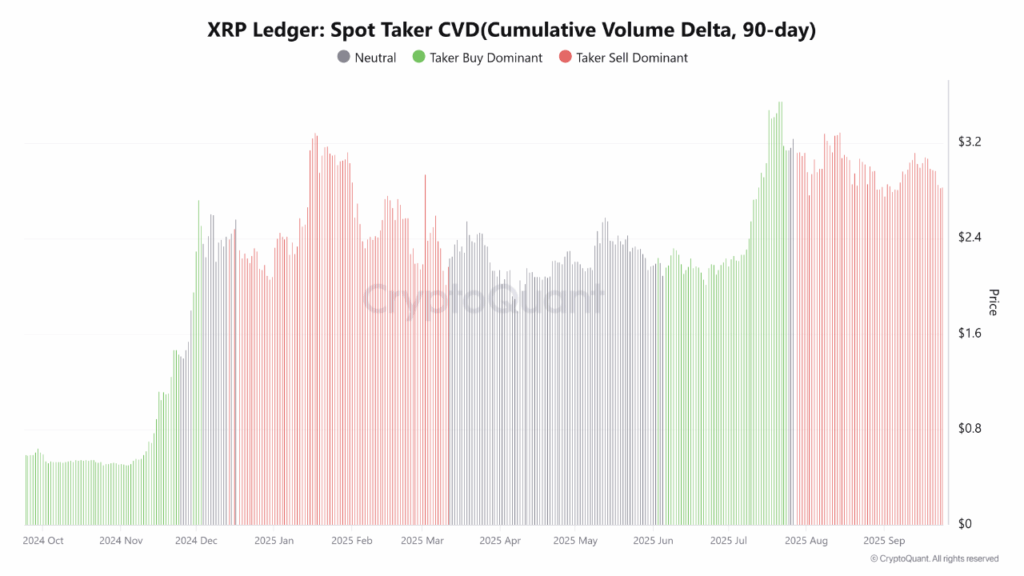XRP spot ETF approval prospects and Spot Taker CVD data show sellers currently control the XRP spot market, limiting sustained buyer momentum; ETF approvals like Franklin Templeton or XRPR could flip demand to institutions and increase liquidity, but key resistances at $3, $3.20 and $3.66 must be breached first.
-
Sellers dominate short-term spot flows
-
Pending XRP spot ETF filings (Franklin Templeton, XRPR) have raised trading volumes and trader attention
-
Critical technical resistance at $3, $3.20 and $3.66; ETF approval may shift liquidity and institutional demand
XRP spot ETF outlook shapes market action: monitor Spot Taker CVD, volume, and $3 resistance to gauge institutional interest — read how to track next moves.
What is driving sellers to dominate the XRP spot market?
Spot Taker CVD data shows cumulative selling pressure has outweighed buys, signaling ongoing profit-taking and resistance to sustained buyer dominance. Traders attribute this to short-term profit-booking ahead of SEC decisions and mixed initial ETF trading volumes that favor active selling over accumulation.
How does the Spot Taker CVD reflect current XRP momentum?
The Spot Taker CVD (90-day) measures net buy versus sell volume and currently reads as seller-biased. In late 2024 buyers briefly pushed momentum higher, but renewed selling has persisted through 2025. Short, sharp selling episodes indicate profit-taking rather than wholesale capitulation.

Cryptoquant
During summer 2025 buyers showed temporary strength, but the Spot Taker CVD reverted as traders sold into rallies. The indicator remains useful for short-term flow analysis; only sustained buyer volume above resistance levels will flip the metric to net-positive.
Why are XRP spot ETF filings affecting market volume and sentiment?
Pending filings, including Franklin Templeton’s extended review and XRPR’s launch (REX/Osprey recorded roughly $37.7 million in first-day volume), have increased market attention. ETF-related activity typically brings elevated front-loaded volume and volatility as traders position for regulatory outcomes.
Market participants expect approvals to unlock regulated institutional flows, but regulatory timelines and SEC review cycles create intermittent rallies followed by profit-taking. Some ETF optimism is already priced in; traders now watch volume for confirmation of institutional participation.
When could key price levels confirm a directional shift?
Breaching and holding above $3 would be an initial bullish signal. Further confirmations would require clears of $3.20 and $3.66 on higher-than-average volume. If these levels fail, downside targets range from $2.4 to $1.8 depending on selling intensity and liquidity drains.
Frequently Asked Questions
Will an XRP spot ETF approval guarantee higher prices?
Approval would likely increase institutional access and liquidity, creating upward pressure, but price impact depends on the scale of inflows and market conditions; approval is supportive, not an automatic price guarantee.
How can traders use Spot Taker CVD to time positions?
Spot Taker CVD highlights net buy vs sell pressure. Traders look for sustained positive divergences with rising volume to confirm accumulation, and use negative divergence near resistance as a signal for profit-taking or protective risk management.
Key Takeaways
- Sellers in control: Spot Taker CVD shows persistent selling and short-term profit-taking.
- ETF attention: Pending filings (Franklin Templeton, XRPR) have increased volume but not yet confirmed institutional accumulation.
- Technical triggers: Hold above $3 and breaks of $3.20/$3.66 on strong volume would favor buyers; failure risks decline to $2.4–$1.8.
Conclusion
XRP spot market dynamics remain supply-driven as sellers dominate short-term flows while ETF developments shape sentiment. Traders should front-load monitoring of Spot Taker CVD, volume, and the $3 resistance zone. Continued attention to official ETF filings and on-chain flow indicators will clarify whether institutional demand can reverse current selling pressure.





